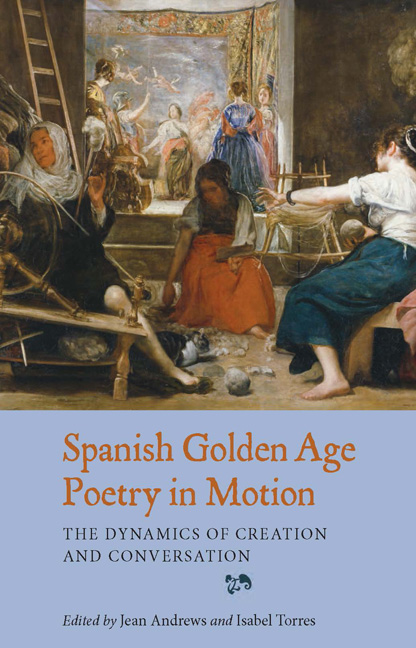Book contents
- Frontmatter
- Contents
- Contributors
- Acknowledgements
- Introduction
- 1 La poesía mutante del Siglo de Oro
- Part 1 Poetry in Creation
- 2 Moving in …Garcilaso de la Vega's ‘Dulces prendas por mi mal halladas’
- 3 The Movement of Thought and Feeling in the ‘Ode to Juan de Grial’
- 4 Metaphors of Movement in Two Poems of Fray Luis de León
- 5 El tiempo medido en versos: Camila Lucinda en las Rimas (1609) de Lope de Vega
- 6 Upwards to Helicon: Lope de Vega, the Laurel de Apolo, and Acts of Judgement
- 7 ‘Dulce es refugio’: El peregrino de Góngora se detiene
- 8 The Staging of Góngora's Three Funereal Sonnets for Margarita de Austria Estiria
- 9 Jealousy in María de Zayas's Intercalated Poetry: Lyric Illness and Narrative Cure
- 10 Hacia otra lectura del petrarquismo en Sor Juana Inés de la Cruz
- Part 2 Poetry in Conversation
- 11 El conde de Salinas y Leonor Pimentel: cuando se juntan el amor y la poesía
- 12 Poesía popular en movimiento: los jeroglíficos ‘muy propios al intento y muy de su profesión’ en las celebraciones de la Valencia barroca
- 13 Responding to Góngora: María Rosal and the Clori Poems
- 14 Traveling in Place: Baroque Lyric Transports in Translation, or Flames that Bridge the Stream
- Works Cited
- Index
3 - The Movement of Thought and Feeling in the ‘Ode to Juan de Grial’
Published online by Cambridge University Press: 05 November 2014
- Frontmatter
- Contents
- Contributors
- Acknowledgements
- Introduction
- 1 La poesía mutante del Siglo de Oro
- Part 1 Poetry in Creation
- 2 Moving in …Garcilaso de la Vega's ‘Dulces prendas por mi mal halladas’
- 3 The Movement of Thought and Feeling in the ‘Ode to Juan de Grial’
- 4 Metaphors of Movement in Two Poems of Fray Luis de León
- 5 El tiempo medido en versos: Camila Lucinda en las Rimas (1609) de Lope de Vega
- 6 Upwards to Helicon: Lope de Vega, the Laurel de Apolo, and Acts of Judgement
- 7 ‘Dulce es refugio’: El peregrino de Góngora se detiene
- 8 The Staging of Góngora's Three Funereal Sonnets for Margarita de Austria Estiria
- 9 Jealousy in María de Zayas's Intercalated Poetry: Lyric Illness and Narrative Cure
- 10 Hacia otra lectura del petrarquismo en Sor Juana Inés de la Cruz
- Part 2 Poetry in Conversation
- 11 El conde de Salinas y Leonor Pimentel: cuando se juntan el amor y la poesía
- 12 Poesía popular en movimiento: los jeroglíficos ‘muy propios al intento y muy de su profesión’ en las celebraciones de la Valencia barroca
- 13 Responding to Góngora: María Rosal and the Clori Poems
- 14 Traveling in Place: Baroque Lyric Transports in Translation, or Flames that Bridge the Stream
- Works Cited
- Index
Summary
Our understanding of the ‘Ode to Juan de Grial’ has been deepened in recent years by research into the sources on which it draws. In 1979 Fernando Lázaro Carreter showed that the model Fray Luis had foremost in his mind was a neo-Latin poem written in Florence by the humanist Angelo Ambrogini Poliziano (1454-94) to mark the start of the academic year. This Fray Luis adapted, in accordance with the precepts of mixed imitatio, blending into it further elements, both classical (mainly from Horace, Virgil and Ovid) and Italian (Bernardo Tasso), in order to produce a distinctive poem of his own. Subsequent scholars have built on the approach that Lázaro Carreter pioneered, and the detailed knowledge of its Latin context that we now possess may be seen in the dense notes that accompany it in the edition of the poems by Antonio Ramajo Caño. Less attention, however, has been paid to how Fray Luis ordered the material of which his poem consists in order to induce in the reader a particular experience of the text.
The analysis of the poem's structure followed by Lázaro Carreter has been accepted, on the whole, without demur. According to this reading the ode falls into four parts: Stanzas 1-3 describe the onset of autumn; Stanza 4 notes that the season invites one to study; Stanzas 5-7 exhort Grial to accept the invitation and write; and Stanza 8 evokes the poet's inability to join him in the task.
- Type
- Chapter
- Information
- Spanish Golden Age Poetry in MotionThe Dynamics of Creation and Conversation, pp. 59 - 72Publisher: Boydell & BrewerPrint publication year: 2014

